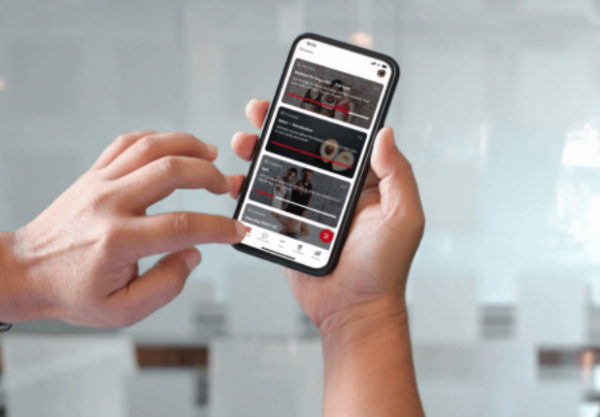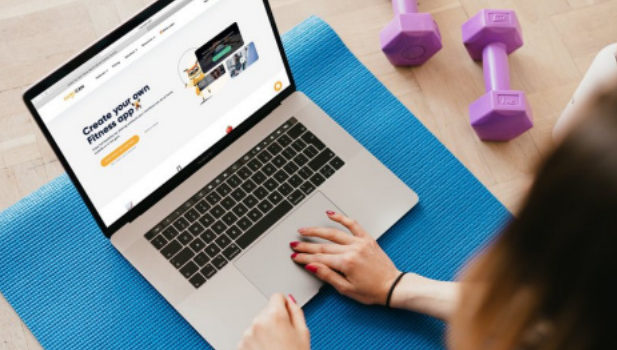How to Create and Have Your Own Fitness App
During the COVID-19 lockdown, gyms have lost thousands of customers. Subsequently, a lot of money went down the drain. Could this disaster have been prevented?
Heck, yes.
Even with gyms closed, people still found a way to stay active at home. Fitness apps have saved the quarantine days–and will continue doing so.
Apps are the future of fitness. And you, trainer or gym owner, are about to learn how to create your own fitness app.
No in-person classes? No headaches, no closing down, AND a steady income.
(FYI, 60 percent of Americans plan to CANCEL their gym memberships, thanks to the practicality of fitness apps!)
Don’t fool yourself: it’s never been easier to have your own fitness app. When you choose the right platform with the right services, all that scary tech language becomes a walk in the park.
Benefits of Having a Fitness App
It’s not only about offering performance metrics to users and calling it a day. It’s about offering in-depth features that thoroughly educate them and offer the best remote experience. And of course, a fitness app should give you a trusted source of extra income.
The benefits of owning a fitness app (depending on your platform of choice) include: For the User
On-the-go availability (even offline!)
Webinars, courses, videos, and a variety of learning mediums inside one app.
A personalized experience, custom-made for your body type and nutrition goals.
Membership prices that respect your budget.

For the Creator
Reliable, consistent monthly revenue.
Available analytics for sales tracking and user task completion.
Community chats for instant user feedback.
Yearly and monthly subscriptions based on your business’s needs.
And that’s not even all of it.
Now that you know the perks, this guide will go over every single step you must take to have a successful fitness app.
Let’s dive right into it.
How to Create a Fitness App in 4 Easy Steps
Step 1: Decide Which Kind of App You Want to Create
Sure, you’ll get help from professional developers later on. But first, you’ve got a lot of planning to do. First things first, there are different types of fitness apps. These are:
Diet and Nutrition Apps
These apps are great for those looking to lose weight, track their calories, and build muscle.
Upon creating an account, users will set their nutrition goals, as well as set their body measurements, height and weight. A range of features is available to them, including:
Calorie trackers
Healthy recipes to match their goal, whether that’s losing or gaining
Daily reminders
Chats and forums to share and receive tips from other users
Before and after progress (pictures and videos)
As we know, dieting can be tough to handle. That’s why the aim of nutrition apps is to continuously motivate and inspire users to keep their focus, no matter what.
Nutrition apps to base yourself on: MyFitnessPal, Gurucan
Activity Tracking Apps
This type of app is for those who like keeping track of how many steps they’ve taken, how many calories
they’ve burned, as well as how many hours they’ve exercised.
Activity tracking works well as an app on its own or as a feature. That’s because visualizing your performance as specific numbers motivates you to strive for even higher the next time.
For activity tracking, features may include:
- Number of calories burned after walking/exercising
- Water intake
- UV Exposure
- Exercise duration
- Number of steps taken
Plus, the above features make this kind of app perfect for users who don’t necessarily look for meal plans or targeted exercises. They might just be looking for a comprehensive platform to document their daily habits.
Activity tracking apps to base yourself on: MyFitnessPal, RunKeeper
Workout Apps
These bad boys can be even better than live personal trainers. No wonder people were all over workout apps while stuck at home this year.
The first great thing about these apps is no commute. You’re (seriously) one click away from a workout created especially for your body type and based on what you want to achieve. All you have to do is create a profile with your information and fitness goals.
Here’s what workout apps have to offer:
- Training variations (strength training, cardio, or yoga)
- Custom workouts based on your preferences (upper/lower body strength)
- Demonstration videos/pictures to make sure you get the most out of your workouts. Timers to count minutes between reps and/or full workouts
- Rewards for accomplished workouts
Workout apps are like a gym in your pocket. Also, no equipment, no problem! There are countless bodyweight exercises to choose from.
Workout apps to base yourself on: Gurucan, 8fit, SWEAT
Step 2: Plan the Features of Your App
Not two fitness apps are the same. Still, there are certain mainstream features you should consider when planning your app. After all, they’ll help your user have a personalized experience and remember all of their tasks.
Here are a few basic features you should remember:
Custom User Profiles
This is by far the most basic and important feature. A fitness app should be 100 percent customized for each user. They should be able to track and update their performance without any issues.
Plus, users should have freedom to access their profile from different devices (phone, tablet, or desktop).
Push Notifications
Your users need consistent motivation. Push notifications are the best way to remind them that the app is still there, or that their next workout is approaching.
Brief reminders aren’t annoying or distracting. Quite the contrary. In-app messages that update them on their fitness progress or a simple “get up and go” encouragement can go a long way.
Sharing Options
Ever seen your friends post their fitness progress on Instagram? That’s a huge boost for them!
When you include sharing options for Instagram, Twitter, and other social networks, users feel pumped to “show off”. And that’s not a bad thing at all. Besides motivating them to strive for their best, sharing is an awesome way to promote your app.
Step 3: Choose How to Monetize the App
Another crucial step, of course, is to make money. But how can you choose the best monetization methods for your goals? You’ve got in-app purchases, premium subscriptions, sponsored content…what’s the difference?
Let’s see.
Premium Features
You can choose to offer certain features in the app for free (such as a personal profile and certain workouts), and set a premium fee in case users want access to advanced features. These may include personal coaching, advanced workouts, and more.
In-app purchases
While the app is free, you can still make profit by offering paid content once users download it. This includes the premium features mentioned above.
Paid apps
Before downloading the app, users must buy it. You can offer a free trial for them to get a feel for it without any cost. The pricing will depend on the fitness app content, the platform you’re using, and type of application.
Sponsored Content
This is your chance to pair up with expert fitness gurus and renowned gyms to earn credibility (and money!). Well-known people and brands can give your app the recognition it deserves and fill your app with professional knowledge people will be dying to get their hands on.
Advertising
Let’s not forget pay-per-click. Allowing other fitness, nutrition, or yoga apps to advertise on YOUR app gives you a CPM (cost-per-mile) or CPC (cost-per-click) share.
Now, on to the good stuff…
Step 4: Download a White Label Fitness App Solution
That’s right. To create an app, you should download an app.
But not just any app.
A White Label (WL) app solution is all about YOUR brand. That means every piece of content you upload
is 100 percent yours. No logos from the developer, no ownership of your content or courses. And guess what? That’s what makes your audience grow like crazy.
That’s why you should choose your platform wisely! There are numerous knowledge-offering apps out there, but not all of them will give you the tools you need.
For instance, below is a comparison of Fitness app builder Gurucan and other online learning platforms:
Now, when it comes to fitness, yoga, and nutrition apps, they all sound the same, right? Well, not really.
Of course, it’s up to you to choose your preferred app. But know that some of them are more costly, and you have cheaper yet equally qualified alternatives.
The process is simple. For example, with Gurucan, all you have to do is sign up and fill out a questionnaire. Then, get in touch with the expert team of developers and they’ll lead you every step of the way.
Really, it’s never been this easy to have your own fitness app.
And now, for the million dollar question…
How Much Does It Cost to Make a Fitness App?
To find out how much you’d pay to create a White Label fitness app, get a FREE cost estimate from Gurucan’s mobile development cost calculator. Create your own fitness app, your way.

















